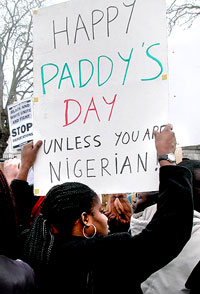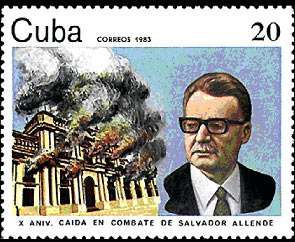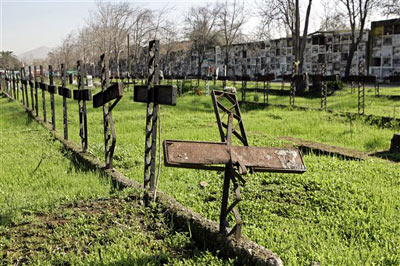|
In the midst of 1970s Ireland, a country considered homogenous and mono-cultural, a small
group of South Americans made their home, under a United
Nations-sponsored programme of resettlement. Long before the
era of mass migration to the country, beginning in the 1990s,
but long after the first migrants sought refuge in Ireland in the seventeenth century, Chileans fleeing the aftermath of
the Pinochet coup travelled to the island. This article
examines the background to the settlement, the circumstances
of their arrival, and the consequences of the move.
The first significant group of refugees to seek asylum in Ireland
were the French Huguenots. Over 200,000 Huguenots left France in the late seventeenth century in the wake of widespread
persecution and the revocation of the Edict of Nantes, which
had granted them religious liberty. About 10,000 settled in Ireland, while 50,000 settled in
England, and these French Protestants are said to have coined the
term 'refugee' in the English language. These forced migrants
gradually settled in the country, learned the language and
intermarried with the Irish population.
Just two decades later, in 1709, the Irish House of Commons
authorised the settlement of Protestant Palatines in
Ireland. The Palatines were fleeing the conflict with the French in
their homeland in the Palatinate (Pfalz) in present-day
Germany. Over 3,000 Palatines moved to
Ireland
in that year, the majority of whom settled on the estate of
Lord Thomas Southwell in Rathkeale,
County Limerick. Similarly to the group of Chilean refugees who settled in
Ireland
over 250 years later, over half of the Palatine refugees were
dissatisfied with the refuge provided in
Ireland
and re-emigrated to
North America.
Few migrants sought refuge in Ireland during the nineteenth and early twentieth century, and in the
aftermath of the Second World War, the Irish government was
reluctant to accept European refugees. The Department of
Justice particularly opposed the resettlement of Jewish
refugees in the state. [1] In 1956,
Ireland acceded to the Geneva Convention relating to the Status of
Refugees, which had been ratified by the United Nations in
1951. The policy of accepting programme refugees in
Ireland, despite its initial limited scope, was conceived of as an
international response to crisis situations. The Convention
defined a refugee as any person who,
owing
to well-founded fear of being persecuted for reasons of race,
religion, nationality, membership of a particular social group
or political opinion, is outside the country of his
nationality and is unable, or owing to such fear, is unwilling
to avail himself of the protection of that country; or who,
not having a nationality and being outside the country of his
former habitual residence as a result of such events, is
unable or, owing to such fear, is unwilling to return to it.
[2]
|

Residents Against Racism (RAR)
protest
in Dublin, 2005
(ex-Pioneer) |
Under the terms of the 1951 Convention, this was to apply
only to European people who were refugees because of events
that had taken place prior to 1951.
The same year that Ireland signed up to the Convention, a
group of 530 Hungarian refugees fleeing the Soviet invasion of
Hungary were accepted into the country and accommodated in an
army camp in Knockalisheen, County Clare. Many more Hungarian
refugees received asylum in other European countries, and,
curiously, also in Chile. [3] The Irish government made scant provision for their
resettlement, beyond providing accommodation, food and 'pocket
money,' [4] and considered their residence in
Ireland to be temporary. Like the Palatines before them, the vast
majority of the Hungarians in
Ireland
ultimately resettled in the
USA
and Canada. In 1966, the Protocol relating to the Status of Refugees
extended the right to seek asylum to all nationalities,
without geographical or chronological limitations. [5]
However, there was no significant refugee migration to Ireland
until the 1970s.
On the eve of Salvador Allende's ascent to power in Chile in 1970, the country was beset by chronic economic
difficulties such as inflation and unequal income
distribution. During his time in power, Allende implemented a
policy known as 'la vía chilena al socialismo' involving the
nationalisation of certain industries, reform of the
healthcare system, agrarian reform and the redistribution of
farms, and a programme of free milk for children. A visit by
Cuban dictator Fidel Castro to Chile
in late 1971 and rampant inflation in 1972 elicited domestic
and international criticism for Allende's administration. This
was compounded by a series of industrial strikes and a fall in
exports. In June 1973, a tank regiment led by Colonel Roberto
Souper led a violent but unsuccessful coup attempt. In August
of the same year, the Chilean Chamber of Deputies accused the
Allende administration of unconstitutional acts and encouraged
the military leadership to reinstate the constitutional order.
On 11 September 1973, the Chilean military led by Commander-in-Chief Augusto
Pinochet overthrew Salvador Allende's socialist government.
Allende made his final radio speech to the people at eleven
o'clock that morning, concluding with the words:
¡¡Viva
Chile!! ¡¡Viva el pueblo!! ¡¡Vivan los trabajadores!! Estas son
mis últimas palabras y tengo la certeza de que mi sacrificio
no será en vano. Tengo la certeza de que por lo menos será
una lección moral que castigará la felonía, la cobardía y
la traición. [6]
A short time later, Allende died in the presidential palace,
'La Moneda,' which was bombed and burnt to the ground. [7] The
Congress was dissolved and the National Stadium converted into
a concentration camp for thousands of prisoners. All political
activity was declared 'in recess.' [8] The coup initiated a
spate of kidnapping, detention, torture and killing of
Chileans by the state. Because of the secrecy surrounding such
activities, and the fact that the locations of bodies were
frequently concealed from their families, victims of this
state terror became known as 'detenidos-desaparecidos
(detained-disappeared).' [9]
|

Cuban
postage stamp commemorating Allende's death
(www.en.wikipedia.org)
|
As news of the coup in
Chile
reached the
Republic
of Ireland, a group of Irish people formed to lobby for the acceptance
of a quota of refugees from the South American country. The
group had the support of the United Nations High Commissioner
for Refugees, who was then encouraging governments all over
the world to accept those seeking refuge from the fallout of
Pinochet's coup. Ireland
and Luxembourg were the only remaining members of the European Union that had
not accepted Chilean refugees. Local support was also provided
by Amnesty International and the Irish Order of the
Franciscans. The Irish government of the time agreed to admit
just twelve families under a special programme for refugees.
The requests of Chileans for refuge were to be granted on the
basis that they would otherwise have been imprisoned or
suffered human rights violations because of their political
beliefs. [10] Unlike the Hungarians in 1956, the Chileans were
to be considered permanent settlers rather than temporary
refugees. [11]
Unfortunately, relatively little is known about this
group, as some of the files relating to the incident have been
mislaid in government archives. [12] The one file that does
remain originated in the Department of the Taoiseach (Prime
Minister) and was released to the public in 2005. It is
entitled 'Resettlement in
Ireland
of refugees from
Chile' and is dated February to April 1974. Although a government
memorandum indicated support for the project from all
departments, the Fine Gael T.D. (member of parliament) and
Minister for Justice Patrick Cooney voiced his reservations in
relation to the settlement of the Chileans, stating that
Ireland was not as 'cosmopolitan' as other Western European
countries and that 'the absorption of even a limited number of
foreigners of this kind could prove extremely difficult.' [13]
Cooney substantiated his views by referring to the previous
resettlement of Hungarian refugees in
Ireland, claiming that they had 'failed to settle down' and had
eventually re-emigrated to other countries. [14]
|




